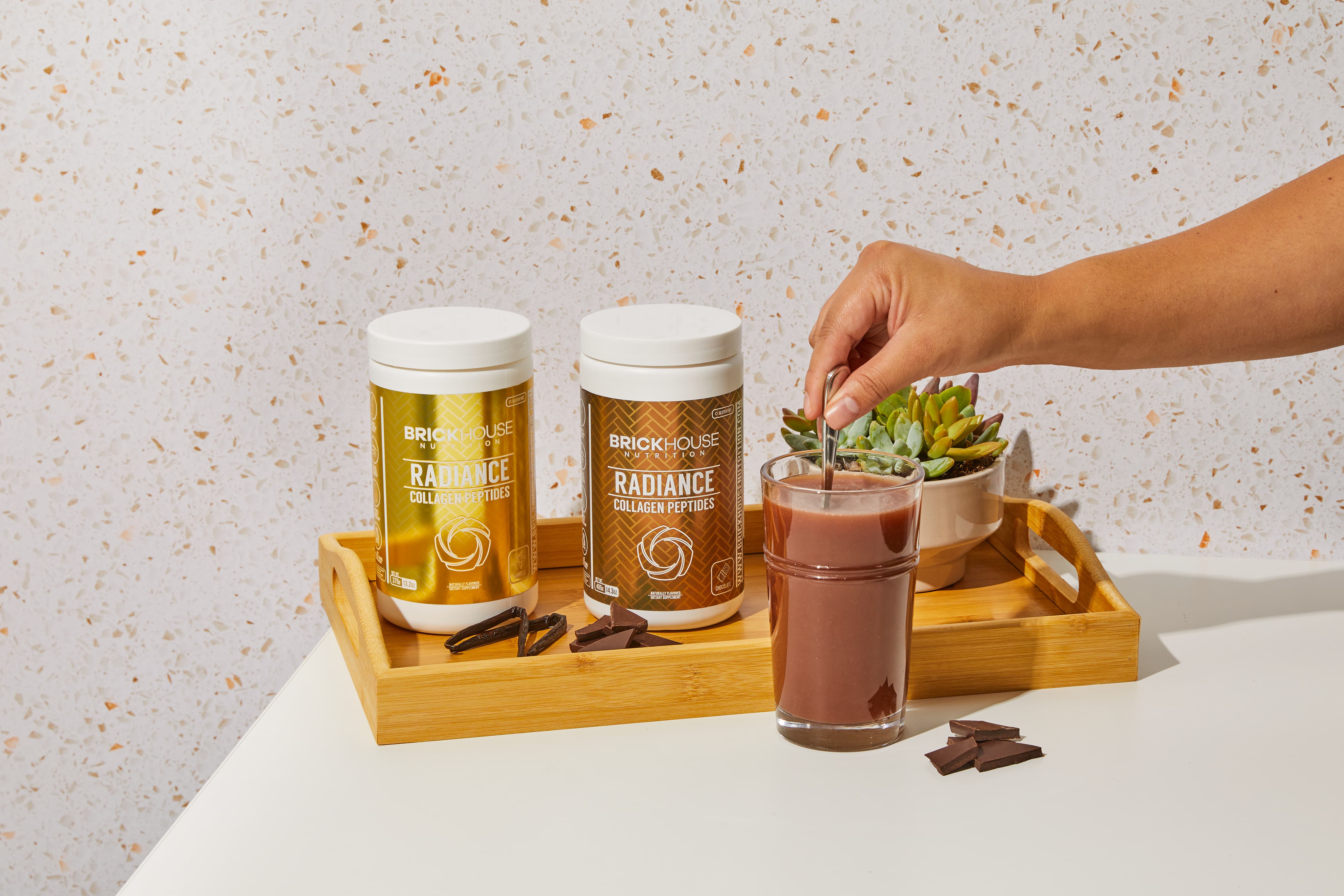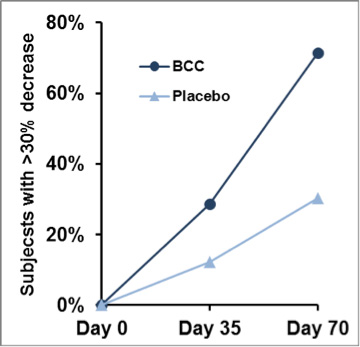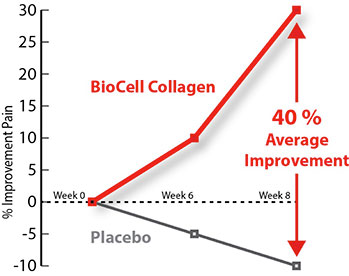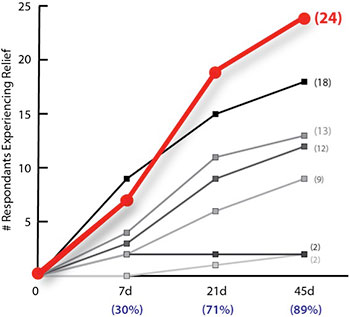Your cart is empty
Free shipping on all US orders


Free shipping on all orders

Not all collagen is created equal. The type, source, molecular size, composition, and manufacturing processes can differ greatly between collagen products. Radiance uses a special matrix of collagen that has undergone almost two decades of development, complete with clinical trials.
Healthy, lustrous hair
Joint comfort & mobility
Strong, beautiful nails
Post-exercise recovery
Reduce facial lines, wrinkles and crow’s feet
Skin elasticity and moisture
The peer-reviewed study was published in the Journal of Agriculture and Food Chemistry. (https://pubs.acs.org/doi/10.1021/jf205295u) (Schauss et al., 2012).
Results of study – Min. 30% improvement in 71% of subjects taking BioCell Collagen

The study details were presented at the international conference of Experimental Biology, 2004, Washington, DC.
Results of the study – 40% improvement

Results of study – Effective in 89% of subjects

The study findings were published in the Journal of the International Society of Sports Nutrition (JISSN): http://www.jissn.com/content/11/S1/P48
1. Ingestion of BioCell Collagen®; enhanced blood microcirculation and reduced facial aging signs.
Collagen Supplementation: An Overview
Collagen comes in many forms (at least 28!), and it is incorporated into nearly all of our body’s tissues. In fact, over 30% of all the body’s proteins are in the form of collagen. Unbeknownst to most people, collagen is the most abundant protein in the body. Where we really come to care about collagen is in our skin, hair, bones, cartilage, and joints. However, as we age, our bodies produce less and less collagen, leading to undesirable wrinkles, dry skin, aching joints, and brittle bones.
Differences in Skin with Sufficient or Insufficient Collagen.
Collagen, like other proteins, is made up of amino acids, which are the building blocks of skin, tendons, muscles, and most other essential bodily structures. A key feature of collagen’s amino acid composition is a high concentration of the anti-aging amino acid, glycine, which has recently demonstrated robust effects in the prevention of aging (1). What is truly unique about collagen is its triple helical structure, just like a braid of hair or a steel cable; it is strong but elastic, firm yet pliable. As you can see, these are the properties that make collagen so vital for maintaining healthy joints and youthful skin.
Taking a collagen supplement has been shown to effectively combat declining collagen levels, as well as maintain and improve already healthy skin and joints. Much of the damage incurred on skin comes from radiation exposure, in other words, sunlight. Pyun et al. (2) found collagen supplementation to greatly improve skin hydration, elasticity, and color after exposure to sunlight. Kim and colleagues (3) concluded that collagen supplementation “is not only an anti-wrinkling agent but also a potent candidate as a [skin] moisturizer.” Collagen has also demonstrated significant improvements in joint discomfort in both those who are young and active (4) as well as the general population (5). Finally, collagen supplementation has been shown to inhibit the deterioration of bone health in aging individuals (6). If we haven’t shown you enough, let’s take a few extra steps.
Collagen: The Science
As stated, collagen is a triple helix structure. It consists of 3 polypeptide chains, or “many amino-acid” chains, all wrapped around one another. Every third amino acid is glycine, while the other two spaces are most often filled by prolines or lysines. Glycine, due to its small size, provides a degree of flexibility and elasticity, while proline and/or lysine, the larger amino acids, deliver rigidity and strength. Each triple helix collagen structure aligns itself next to another, conjoined by a proteoglycan (a protein bound to carbohydrate molecules), until a small fibril is formed. This fibril may stand alone, or, in the case of thicker tissues such as tendons or ligaments, many more collagen fibrils intertwine to form a fiber, similar to that of a steel cable in design.
The amino acid sequence and form of collagen.
In the amino acid sequence, GLY indicates a glycine, while PRO and HYP indicate other amino acids, in this case, proline and hydroxyproline (a proline with an extra oxygen and hydrogen atom).
Another important player to consider when it comes to bodily tissues is hyaluronic acid. Hyaluronic acid has a less complex structure than collagen – it is a straight line of glucosamine and galactosamine, two sugar-amino acid compounds. Hyaluronic acid is very concentrated in “wet” areas of the body, such as the skin, synovial fluid (joint lubricant), cartilage, and bone (the bone marrow houses and makes all the important immune cells that make up our blood system, so it is in fact very “wet!”). Its pivotal role in these wet areas of the body makes hyaluronic acid a very important component for improving joint, skin, and bone health.
Collagen and hyaluronic acid are intimately related and overlap in their function; hyaluronic acid is actually “stored” within collagen. Each fiber (such as a tendon) in our body is made up of thousands of collagen chains, which are held together by proteoglycans. This structure is made up of hyaluronic acids. Therefore, hyaluronic acid and collagen are the building blocks that build the tissues and sinews that hold our body together.
Collagen Fibrils Conjoining with the Help of a Proteoglycan.
For an example of the intimate relationship between collagen and hyaluronic acid in our body, let us consider the knee. There is collagen surrounding the end of the femur (thigh bone) and tibia (shin bone) in the form of an articular cartilage. Articular cartilage is the type of cartilage that comes into contact with another cartilage in a joint. Hyaluronic acid keeps the cartilage malleable, so that it serves to protect the joint from damage due to friction between the weight-bearing bones. It is also present in the synovial fluid, which reduces the friction by providing lubrication within the joint space. Collagen is also found in the ligaments (connecting bone to bone) and tendons (anchoring muscle to bone) surrounding the knee, as well as in the joint capsule (connective tissue surrounding the entire knee joint), which keeps synovial fluid inside the joint. Of course, collagen is also present in the femur and tibia themselves, providing over 90% of the bones total protein (7).
The Differences Between a Healthy Knee and an Arthritic Knee. The cartilage (in blue) is rich in collagen and protects the bones.
In the skin, the biggest organ system in our body, the collagen and hyaluronic acid keep everything firm and smooth. Luckily, much like the other tissues discussed already, our skin is mostly composed of collagen. Lines, wrinkles, and even cellulite occur when the collagen lattice structure in the skin is either damaged or weakened. Collagen works from the inside out; it is created in the fibroblasts of the deep skin and rises to the surface as skin cells die and are washed away. As the collagen rises, the valleys of the lines and wrinkles of the skin are raised to the surface by the new, firm collagen.
Progression of Skin with Low Collagen to Skin with High Collagen. Low collagen content of the skin (left) leaves fine lines and wrinkles, but as collagen proteins rise, they return the lines to their natural position, smoothing the skin.
Many of the general population have a basic understanding of the importance of collagen in our skin, joint, hair and bone health. And some may have even heard of the benefits of hyaluronic acid on skin. However, many probably did not know just how intertwined the two components are in making up the building blocks of our bodily tissues. Together with hyaluronic acid, collagen lubricates the joints to prevent damage due to friction and stabilizes the joint by connecting bones to muscles and other bones. Therefore, collagen supplementation, along with hyaluronic acid synergy, ensures that the body has the sufficient building blocks to form all the components that make up a healthy joint. Without adequate collagen, the joints erode and become stiff and painful. When the skin is left with low amounts of collagen, such as in old age when the fibroblasts produce much less collagen, the skin surface loses its turgor and elasticity, leading to the unsightly wrinkles. The loss of collagen can lead to areas of skin weakness that allow the subcutaneous fat to push and stretch the skin, forming the cottage cheese appearance of what we call “cellulite.” Therefore, collagen and hyaluronic acid supplementation supplies the body with the elasticity, moisture and strength needed for healthy joints and skin.
Radiance and Why it is the complete Collagen Formula
Most collagen formulas are basic in nature. They utilize a beef hide that sources merely collagen I and Collagen III in its’ matrix. As we have read above, there are 28 different types of collagen in the body. Most are made by the body but studies have shown that oral intake of collagen has improved skin, nails, hair, and joints. However, limiting one to just a complex of Collagen I and Collagen III limits our bodies capabilities.
Radiance contains a matrix of collagen peptides of Collagen I, II, III, V, and X. We also utilize a heavily studied ingredient in Biocell Collagen to give you not only the benefits of our collagen blend but also the science. This beloved collagen is a blend of type II collagen, chondroitin sulfate, and hyaluronic acid. Thus far, we have discussed the benefits of collagen but chondroitin sulfate and hyaluronic acid are critical in assisting collagen build joints, cartilage, and cartilage fluidity. So let’s give you a quick rundown of what we have in our product and why having a complex blend of collagen is key to your body's success.
Collagen 1 – Most common type of collagen
Prominent in hair, skin, nails, organs, bones, ligaments.
Supports healthy skin, hair, nails
Best Sources - Beef
Collagen 2 – helps build cartilage, joints, and maintains our gut lining
Supports joint and digestive health
Assists with immune health and function
Best Sources – Chicken
Collagen 3 – Commonly found alongside collagen 1
Supports organs, blood vessels, muscle structure
Best Sources – Beef, Fish
Collagen V – Less abundant but still important
Forms cell membranes, found in eyes, specifically in the cornea
Placenta of expecting mother
Best Sources – Eggs, Multi-Collagen Powders
Collagen X – helps form bones and joints
Best Sources – Eggs(eggshells), Chicken
Hyaluronic Acid – natural substance found in the fluids in the eyes and joint. Acts mostly as a lubricant. This ingredient in combination with collagen can help assist with joint and cartilage fluidity.
Chondroitin Sulfate – a major ingredient in the building of cartilage. A baseline supplement for many that have osteoarthritis. A major component in joints, and human skin.
A Recent systematic review and meta-analysis by Miranda et al, 8 took a look at 19 studies with a total of 1,125 participants aged between 20 and 70 years old. This group consisted of 95% women. This meta-analysis showed favorable results of hydrolyzed collagen supplementation vs placebo. What were the benefits you might ask? They were all the things we discussed above about the benefits of Radiance. The studies showed that the group taking the collagen supplementation had improved skin hydration, elasticity, and wrinkles. The results were amazing, showing that collagen can delay and improve the signs of skin aging by decreasing facial wrinkles and improving skin hydration. Our formulation with Biocell Collagen only highlights the intricate details we have put into our formula that is backed by customer reviews and backed by science. Another added benefit from this meta-analysis showed that there were no adverse effects reported with all 1,125 participants.
Give Radiance a try, knowing that it is backed by scientific evidence, GRAS (generally recognized as Safe) ingredients by the FDA, and formulated with your best skin, hair, and joints in mind.
We derive collagen powder from animal collagen, from cow hide, fish or chicken. Multiple studies have shown consumption of collagen powder can improve the conditions of skin, bone, hair and joints. More specifically, collagen powder intake can improve the turgor of the skin, decreasing the dryness and wrinkles seen in skin. Collagen powders, like Radiance with a complex matrix of collagen peptides have shown to also provide improvement to overall joint health.
Collagen has a well-established market within the female-targeted,
multi-billion-dollar beauty industry. However, is there a market
niche for collagen targeting men? Men also suffer from dry skin,
wrinkles and joint issues; would they not benefit from the skin
and joint improvements? Most supplements geared towards men are
for the sole purpose of building lean body mass and building more
muscles. And there seems to be a large void in the health and
supplement industry that targets skin and joint benefits for men.
We need to encourage the men to be taking in collagen, as their
joints can wear down and their skin can lose elasticity over the
years, no less than women.
Collagen powders contain a
mix of multiple types of collagen: types I, II, III, V, X. Type I
collagen is the most abundant protein found in humans (and in all
vertebrates). It is the strongest type of collagen, the building
blocks of the skin. If you're looking for a collagen for
supporting skin health, type I is a must. Type II collagen is the
major collagen found in cartilage, important for the connective
tissue around the joints. Type III is a major component of our
skin and organs and is often found in the same locations as type
I. Type V is one of the minor collagen components, forming
interstitial collagen fibers. Type V collagen co-exists with type
II collagen in joint cartilage, while supporting healthy collagen
fibers of type II collagen. Type V collagen also functions to
create the cells of a pregnant women's placenta, which is
literally the start of life. Type X is present in normal joint
cartilage and is known as the “network-forming collagen.”
Breaking down the collagen powder by types, one can see how
collagen can be beneficial to the overall health of skin, hair and
joints. In all honesty, most men would admit that they desire
younger-looking skin and healthy-appearing hair. And as these men
also focus on building muscles, we need to remember to adequately
support the connective tissues and the cartilage in the joints
that connect the muscles. This will prevent injury while lifting
weights and will allow more stability and greater range of motion
as men take on more active sports with their aging bodies.
Most of the men’s supplement shelves are taken up by
muscle building supplements, such as aminos and protein powders.
However, it is time that more attention is given to men building
healthier joints and skin by ingesting literally the building
fibers of the joints and skin. So, the next time you are thinking
of adding a new supplement to your shelf, reach for a collagen
powder product and build a stronger and younger you.
In order to ensure your Radiance dissolves easily and reaches the perfect drinkability, make sure to snag one of our BrickHouse Shakers.
If you sign up for a recurring subscription, we will toss one in as a free gift!